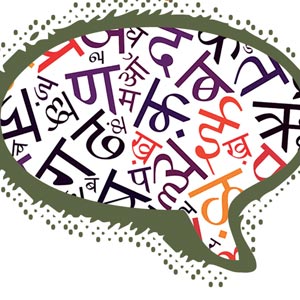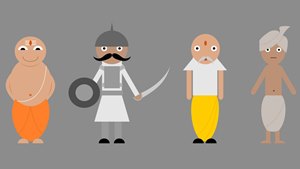Letters from Readers

Hindi works as India’s national language
I read Shashi Tharoor’s article (“Relax chauvinists, Hindi can win the language battle on its own!”) in your December issue. He has some good points but I disagree with his conclusion. Hindi is the only language in India which has all the components to be called the national language. Below I list my views.
• Hindi is the only language spoken and understood by more than half of the population. I estimate that somewhere near 75 percent of Indians understand Hindi.
• Like the other languages, it has its roots in Sanskrit, the original language of the Indian subcontinent. Some scholars call Sanskrit a Eurasian language, because lots of words from Sanskrit appear in Latin, English, German, Greek, and other languages.
• Hindi, like English, has adopted lots of words from Urdu, Persian, English, Greek/Macedonian, and other languages. For example, most Hindi-speaking people understand the word railways and pen rather than the Hindi word lohpathgamini and tulika. The Urdu word kalam is better understood for pen.
• His argument that, “Popular does not mean national,” does not jive. The Hindi which is spoken and understood by the majority is not the literary Hindi. Bollywood movies do not use literary Hindi and that’s why the movies are more popular among the general public.
• English always has been a link language since independence, and it should stay that way. All memos from the center to state governments are in both languages, Hindi and English. I do not see any reason to change this.
• Translation to regional languages has been made easy by the internet.
• It is very true that English is a foreign language. It is an irony that people who speak fluent English in India are considered elite. I have seen and observed this myself during numerous visits to India. Somehow, these days Hinglish is getting more popular among educated people.
There may be some special interest politicians in BJP who are pushing the limits, but the truth is that there is no other language except Hindi which deserves to be the national language.
Ajay Mehrotra
Greenville, SC
|
|
|
|
(image source: goseefeel)
Casteism in IndiaLately there have been several articles in Indian news publications in the U.S. [as well as a book review of Sujatha Gidla’s Ants Among Elephants: An Untouchable Family and the Making of Modern India in the December issue of Khabar] about the caste system in India, some misleading the readers. One writer was wrong in saying that casteism is not mentioned in Hindu scriptures. Another writer was correct in noting that it’s laid down in the Gita and other Vedic scriptures. However, he stopped short of providing any excerpt and/or explanation of what the scriptures say about the caste system, thus leading readers to believe that the present caste system is traditionally approved by the Hindu religion.
I have not had the privilege to read all the Vedic scriptures that this gentleman listed, but let me quote what Krishna says in the Gita: “Caturvarnyam maya srrstam gunakarma vibhagacha,” which literally means “The fourfold caste was created by me [referring to Krishna himself] by the different distribution of guna [attributes] and karma [deeds].” He repeats the divisions once again in chapter 18, in the slokas 42, 43, and 44. He describes the duties of the four varnas [classes] as the division by svabhavajam, one’s behavior.
Swamy Chidbhavananda expounds as follows.
Creation is effected by variation in the distribution of gunas. That jiva [living being] in whom sattva [goodness]-guna predominates is classified as brahmana. He is a kshatriya in whom sattva seasoned with rajas [passion] prevails. The man third in rank is the vaisya imbued mainly with rajas and sparingly with sattva and tamas [darkness]. In sudra the last man, tamas regulated by rajas is in the forefront.
The Vedanta philosophical position is that among four brothers all the four varnas may be evident. Swami Vivekanada quotes in his writings a poem by saint Surdas describing as analogy, “One drop of water is in sacred Jamuna, and another is foul in the ditch by the road side, but when they fall into Ganges both alike become holy.”
As time went by, these four classes expanded into numerous castes, also known as varnas, based on the trades they practiced. The Greek writer Megasthenes, who visited India during the Maurya period, recorded seven varnas: the Philosophers, Husbandries (farmers), Soldiers, Overseers, Councilors and Assessors, Shepherds and Neat herds [cowherds], and Artisans, which included carpenters, blacksmiths, and goldsmiths along with the people who did the lowest professions, known as untouchables (whom Mahatma Gandhi called Harijans, people of God).
In the medieval ages and during Muslim rule, there was not much emphasis on the caste system, but the British Raj encouraged the continuity of the caste system by favoring some groups with higher status and giving them titles and jagirs (land grants), and caste divisions proliferated literally into hundreds.
Reformers such as Dayanand Saraswati and, of course, Gandhi vehemently advocated against the system and discrimination based on caste. The Indian constitution made it illegal after independence, yet provided a reservation system for the lowest in availing of public education, jobs, etc. As India is transforming, one might expect caste to dissolve—unfortunately that is not the situation. The menace of caste is very much prevalent, especially when it comes to marriage, and more so in politics, similar to the race situation in the U.S.
Ramchandra Reddy
Augusta, GA
Error note for “In Memoriam 2017”
We’re grateful to P. T. Rao, a regular and vigilant reader of Khabar, for pointing out some errors
in the birth dates listed in Desi World (December). It’s painful to see mistakes that we could have easily avoided. Our apologies! Correct dates: Vinod Khanna (1946-April 27, 2017). Dasari Narayana Rao (1947-May 30, 2017). Tom Alter (1950-September 29, 2017).
Girija Devi (1929-October 24, 2017).

What’s on YOUR mind?
We welcome original, unpublished letters from our readers. You could either respond to a specific article in Khabar or write about issues relevant to our community. Letters may be edited for length and other considerations. Longer submissions by readers may be considered for the “My Turn” column.
Email: letters@khabar.com • Fax: (770) 234-6115.
Mail: Khabar, Inc. 3635 Savannah Place Dr, Suite 400, Duluth, GA 30096.
Note: Views expressed in the Letters section do not necessarily represent those of the publication.
Enjoyed reading Khabar magazine? Subscribe to Khabar and get a full digital copy of this Indian-American community magazine.
blog comments powered by Disqus













